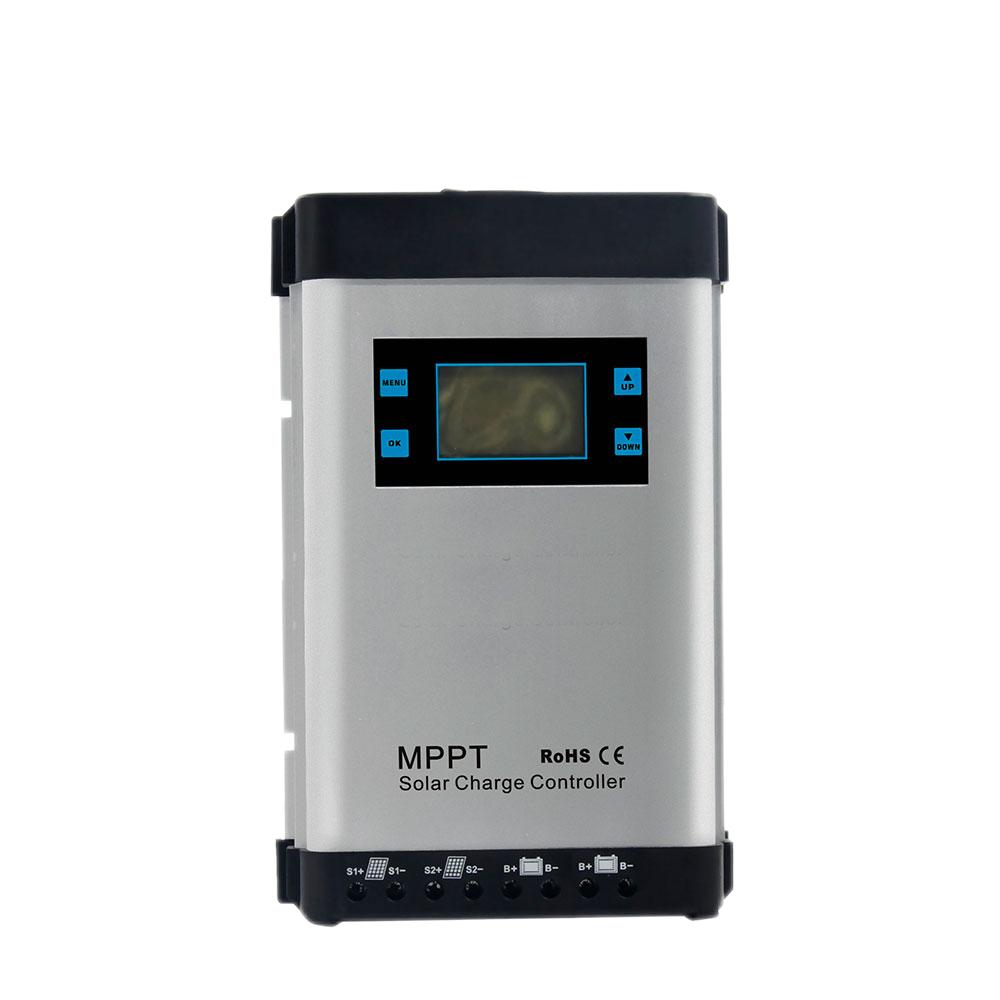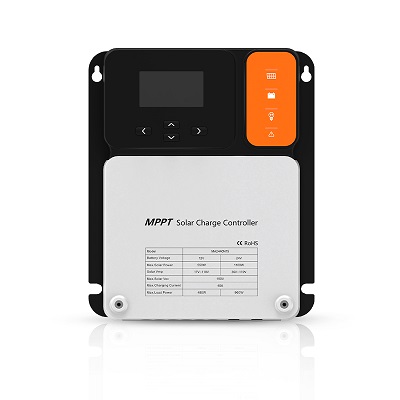Which solar charge controller is better? MPPT or PWM?
With the continuous advancement of renewable energy technology, solar systems have gradually become a popular choice for home and outdoor use. Among the core components of solar systems, solar charge controllers and inverters play a vital role. Understanding how these components work, choosing the right type of controller, and connecting and using them correctly are the keys to making full use of solar resources.
What is the better choice, MPPT or PWM?
PWM (Pulse Width Modulation)
The PWM controller controls the charging process by adjusting the input voltage. It adjusts the output voltage through fast switching to keep the battery in the best state at different charging stages. The working principle of the PWM controller is relatively simple, so its price is relatively low and suitable for users with limited budgets.
Advantages:
1. Low cost: PWM controllers are cheaper than MPPT controllers and suitable for users with limited budgets.
2. Simple and reliable: Due to the relatively simple technology, PWM controllers have high reliability and are easy to maintain and operate.
3. Suitable for small systems: In small solar systems, PWM controllers can provide sufficient performance to meet basic needs.
Applicable situations:
1. Small solar systems: For solar systems with lower power (such as small homes or outdoor camping), PWM controllers can effectively meet the needs.
2. Limited budget: If funds are limited, PWM controllers are a cost-effective choice.
3. Battery voltage matches panel voltage: When the battery voltage is close to the solar panel voltage, the efficiency of the PWM controller is higher.
MPPT (Maximum Power Point Tracking)
The MPPT controller ensures that the solar system operates at the highest efficiency by constantly tracking the maximum power point of the solar panel. It can adjust operating parameters according to changes in environmental conditions (such as light intensity and temperature) to maximize energy output.
Advantages:
1. High efficiency: The MPPT controller can maximize the power output of the solar panel, and the efficiency is 30% higher than that of the PWM controller.
2. Strong adaptability: Whether the voltage of the solar panel matches the battery voltage, the MPPT controller can work effectively.
3. Applicable to large-scale systems: In large-scale solar systems, the high efficiency of the MPPT controller can significantly improve system performance.
Applicable situations:
1. Large-scale solar systems: For large-scale solar systems that require high power output, MPPT controllers are the best choice.
2. Voltage mismatch: When the voltage of the solar panel does not match the voltage of the battery, the MPPT controller can maximize the energy conversion efficiency.
3. Changing environment: In an environment with large changes in light and temperature, the MPPT controller can dynamically adjust to maintain efficient operation.
Summary
MPPT controllers and PWM controllers each have their own advantages and disadvantages. PWM controllers are suitable for small solar systems with limited budgets, with the advantages of low cost, simplicity and reliability. MPPT controllers are suitable for large-scale solar systems that require high efficiency and can maintain efficient operation under different environmental conditions. Which controller to choose should be considered comprehensively based on specific application scenarios, system size and budget.
Can I connect a solar charge controller to an inverter?
It is a common misunderstanding to connect a solar charge controller directly to an inverter. In fact, the main function of a solar charge controller is to regulate the power obtained from the solar panel and store it in the battery. The function of the inverter is to convert the direct current (DC) in the battery into alternating current (AC) for use by home appliances or other devices.
Working Principle
Solar systems usually include four main parts: solar panels, charge controllers, batteries, and inverters:
1. Solar panels: convert solar energy into direct current.
2. Charge controllers: regulate the power obtained from solar panels to prevent overcharging or over-discharging of batteries.
3. Batteries: store power for use when needed.
4. Inverters: convert direct current from batteries into alternating current.
In this system, the output of the charge controller should be connected to the battery instead of directly to the inverter. The inverter should be connected to the battery so that it can take power from the battery and convert it into alternating current when needed.
Connection Method
1. Solar Panel to Charge Controller: First, connect the output of the solar panel to the input of the charge controller. The charge controller will regulate the power output of the solar panel to ensure that the battery is charged within a safe range.
2. Charge Controller to Battery: Connect the output of the charge controller to the battery. This process ensures that the battery can effectively store the power obtained from the solar panel.
3. Battery to Inverter: Finally, connect the output of the battery to the input of the inverter. The inverter converts the DC power obtained from the battery into AC power for use by home appliances or other devices.
Why can't it be connected directly?
Connecting the charge controller directly to the inverter may cause the following problems:
1. Voltage mismatch: The voltage output by the charge controller may not match the voltage required by the inverter, causing the inverter to not work properly.
2. Current fluctuation: The current output by the charge controller may vary due to the fluctuation of the solar panel output, affecting the stability of the inverter.
3. Safety issues: Direct connection may cause electrical system instability and increase fire or other safety risks.
Summary
The solar charge controller should not be connected directly to the inverter. The correct connection method is to connect the charge controller to the battery and then connect the inverter to the battery. This connection method ensures the stability and safety of the system and can fully utilize the advantages of the solar energy system.
Can I use a solar charge controller without an inverter?
The main function of the solar charge controller is to regulate the electrical energy output by the solar panel and store it in the battery. Therefore, even without an inverter, the charge controller can still work effectively. In fact, for some small solar systems or specific application scenarios, it is completely possible to use a solar charge controller without an inverter.
Working Principle
In the absence of an inverter, the basic components of a solar system include solar panels, charge controllers, and batteries:
1. Solar panels: Convert solar energy into direct current.
2. Charge controllers: Regulate the power output of solar panels to ensure that the battery is charged within a safe range.
3. Batteries: Store power for use when needed.
Application scenarios
1. DC devices: Many devices, such as LED lights, mobile phone chargers, small fans, etc., can use direct current directly. These devices can be directly connected to the battery without an inverter.
2. Small off-grid systems: For some off-grid systems, such as remote cabins, outdoor camping, etc., DC systems are usually more efficient and avoid energy loss during AC conversion.
3. Backup power: In some cases, the DC power stored in the battery can be used as a backup power source and directly used for emergency lighting or other critical equipment.
Advantages
1. Cost savings: No inverter can reduce system costs, especially for users with limited budgets.
2. Improved efficiency: Avoiding the conversion process of DC to AC reduces energy loss and improves the overall efficiency of the system.
3. Simple and reliable: The system design and maintenance are simpler, which reduces the number of failure points and improves the reliability of the system.
Notes
1. Equipment compatibility: Make sure that the equipment used can directly use DC power to avoid equipment damage due to voltage mismatch.
2. Voltage regulation: When using different voltage equipment, an additional voltage regulator may be required to ensure that the equipment can operate within a safe voltage range.
3. Load management: Pay attention to the match between battery capacity and equipment power requirements to avoid battery overdischarge or equipment malfunction.
In the absence of an inverter, the solar charge controller can still work effectively and provide power to DC equipment. This configuration is suitable for application scenarios such as small solar systems, off-grid systems, and backup power. Nevertheless, during the design and use process, attention should still be paid to equipment compatibility, voltage regulation, and load management issues to ensure the safe and efficient operation of the system.
Conclusion
The design and application of solar energy systems involve a variety of components and technologies. Understanding and selecting the right solar charge controller, correctly connecting and using the inverter, and efficiently utilizing DC power without an inverter are the keys to achieving efficient operation of solar energy systems. This article aims to provide readers with a comprehensive guide to help everyone better understand and apply solar energy technology. By properly configuring and optimizing the use of solar energy systems, we can not only save energy costs, but also contribute to environmental protection. I hope this article can inspire your interest in solar energy systems and benefit you greatly in practical applications.







